An Analysis of Budgetary Process and Behavioural Aspects in Accounting
VerifiedAdded on 2023/06/04
|12
|2558
|310
Essay
AI Summary
This essay provides a comprehensive overview of the budgetary process in management accounting, detailing the sequence of steps involved, including updating budget assumptions, noting available funding, identifying step costing points, developing budget packages, obtaining revenue forecasts, and securing departmental budgets. It critically examines the behavioural aspects of budgeting, addressing issues such as dysfunctional behaviour, participative budgeting challenges, additional pressure created by budgets, budgetary slack, inter-departmental conflict, and the importance of top management support. The essay concludes that a well-managed budgetary process, with careful consideration of human behaviour, is essential for organizational success, especially in managing expenses and increasing income. Desklib provides students with access to this essay and a wealth of other study resources.
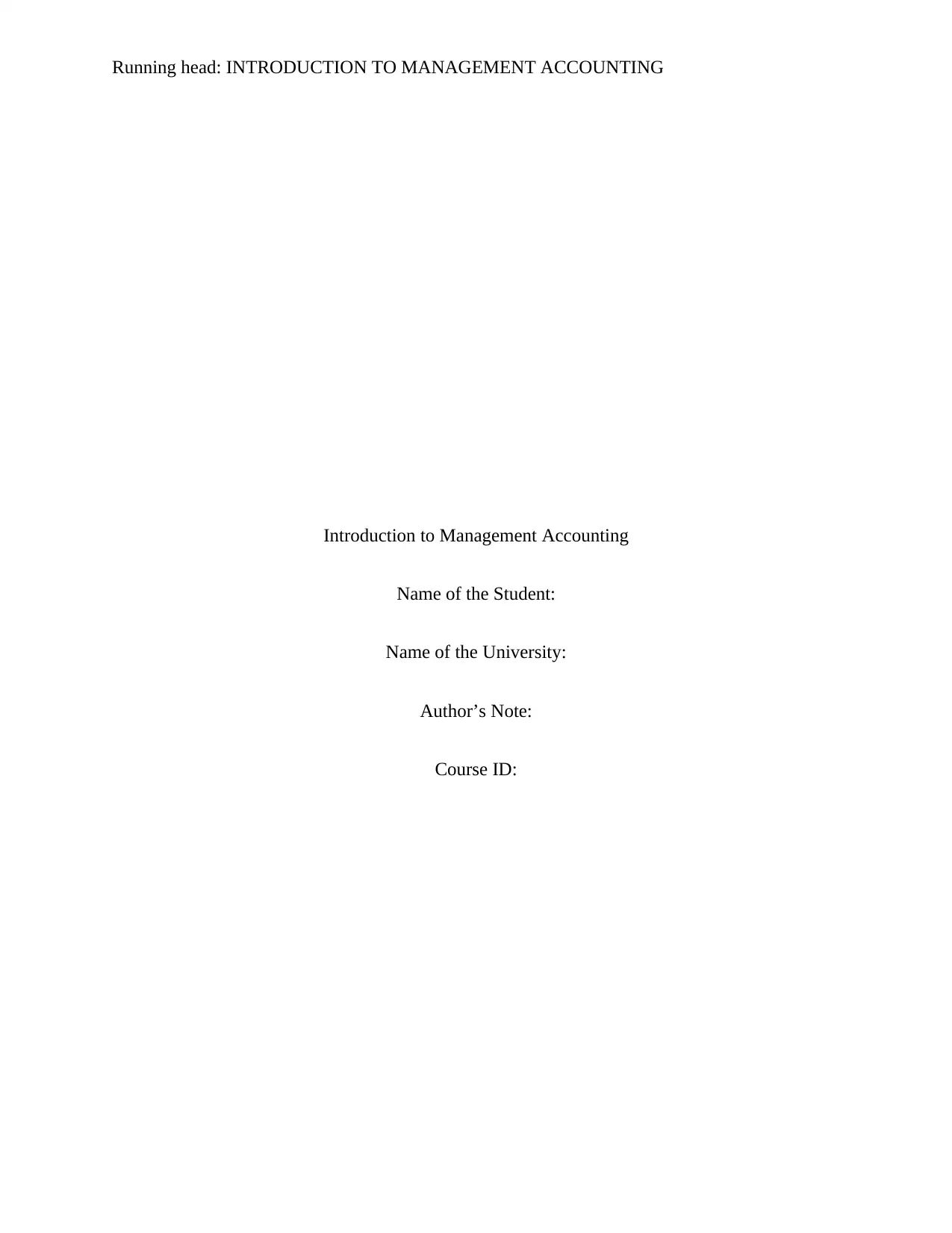
Running head: INTRODUCTION TO MANAGEMENT ACCOUNTING
Introduction to Management Accounting
Name of the Student:
Name of the University:
Author’s Note:
Course ID:
Introduction to Management Accounting
Name of the Student:
Name of the University:
Author’s Note:
Course ID:
Paraphrase This Document
Need a fresh take? Get an instant paraphrase of this document with our AI Paraphraser
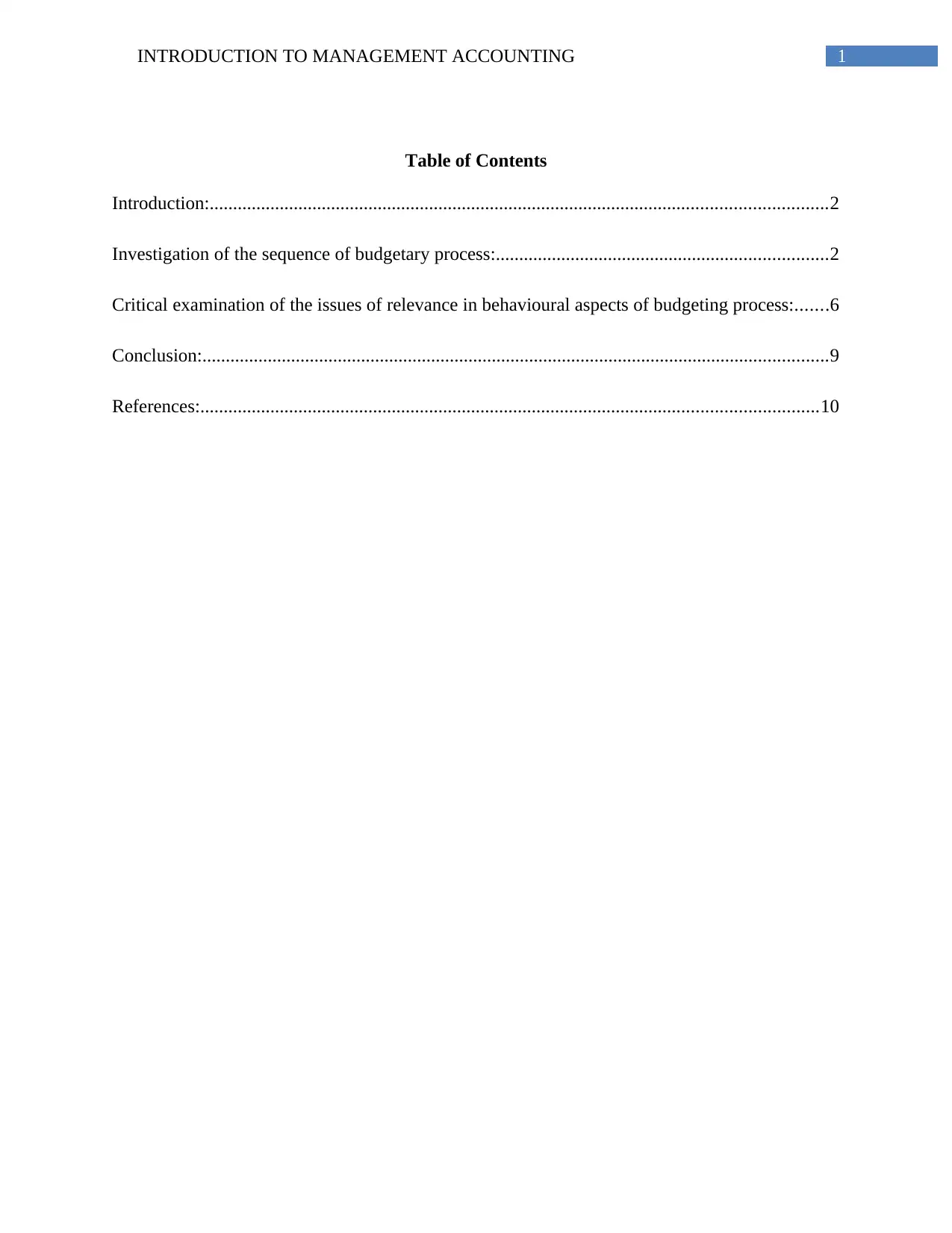
1INTRODUCTION TO MANAGEMENT ACCOUNTING
Table of Contents
Introduction:....................................................................................................................................2
Investigation of the sequence of budgetary process:.......................................................................2
Critical examination of the issues of relevance in behavioural aspects of budgeting process:.......6
Conclusion:......................................................................................................................................9
References:....................................................................................................................................10
Table of Contents
Introduction:....................................................................................................................................2
Investigation of the sequence of budgetary process:.......................................................................2
Critical examination of the issues of relevance in behavioural aspects of budgeting process:.......6
Conclusion:......................................................................................................................................9
References:....................................................................................................................................10
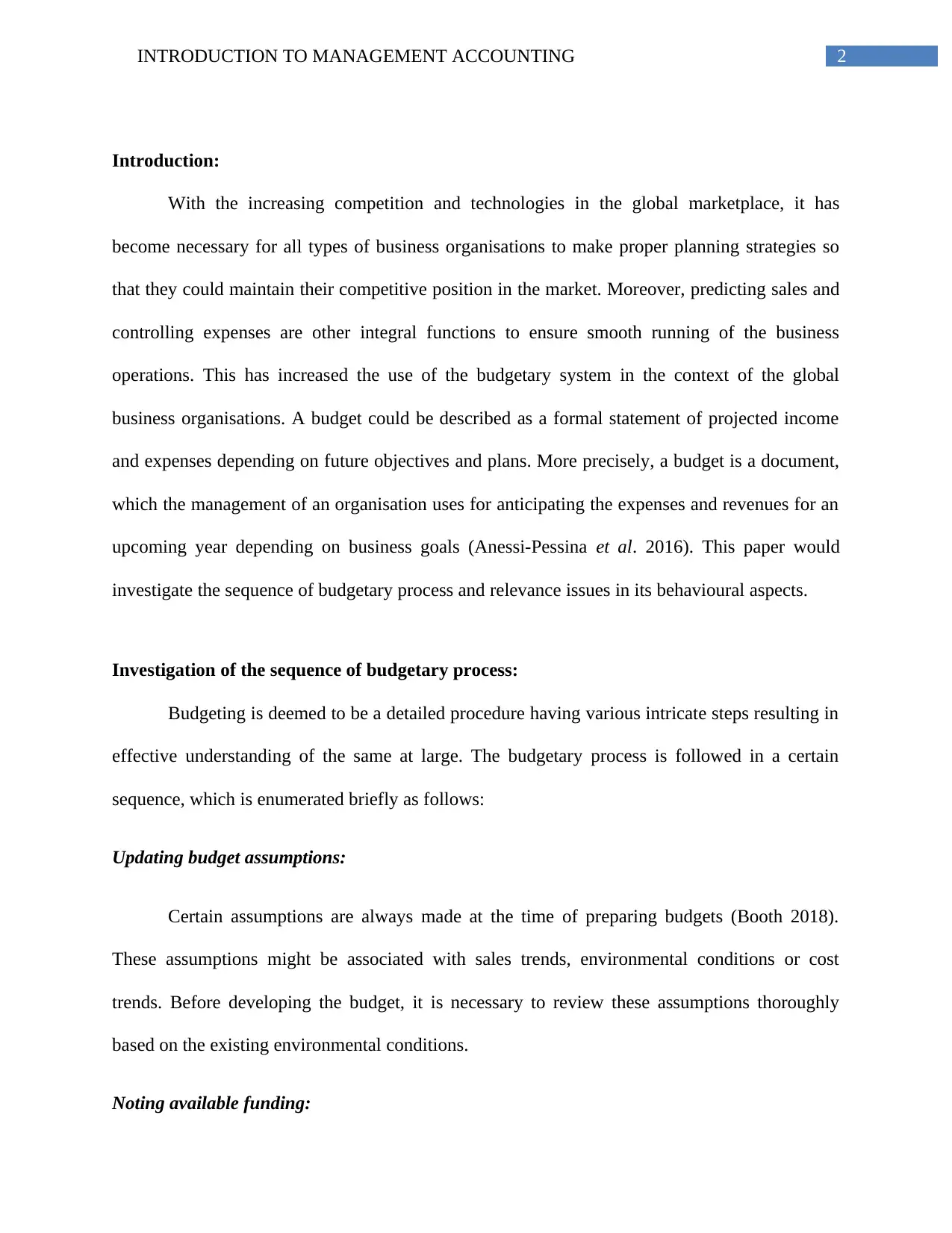
2INTRODUCTION TO MANAGEMENT ACCOUNTING
Introduction:
With the increasing competition and technologies in the global marketplace, it has
become necessary for all types of business organisations to make proper planning strategies so
that they could maintain their competitive position in the market. Moreover, predicting sales and
controlling expenses are other integral functions to ensure smooth running of the business
operations. This has increased the use of the budgetary system in the context of the global
business organisations. A budget could be described as a formal statement of projected income
and expenses depending on future objectives and plans. More precisely, a budget is a document,
which the management of an organisation uses for anticipating the expenses and revenues for an
upcoming year depending on business goals (Anessi-Pessina et al. 2016). This paper would
investigate the sequence of budgetary process and relevance issues in its behavioural aspects.
Investigation of the sequence of budgetary process:
Budgeting is deemed to be a detailed procedure having various intricate steps resulting in
effective understanding of the same at large. The budgetary process is followed in a certain
sequence, which is enumerated briefly as follows:
Updating budget assumptions:
Certain assumptions are always made at the time of preparing budgets (Booth 2018).
These assumptions might be associated with sales trends, environmental conditions or cost
trends. Before developing the budget, it is necessary to review these assumptions thoroughly
based on the existing environmental conditions.
Noting available funding:
Introduction:
With the increasing competition and technologies in the global marketplace, it has
become necessary for all types of business organisations to make proper planning strategies so
that they could maintain their competitive position in the market. Moreover, predicting sales and
controlling expenses are other integral functions to ensure smooth running of the business
operations. This has increased the use of the budgetary system in the context of the global
business organisations. A budget could be described as a formal statement of projected income
and expenses depending on future objectives and plans. More precisely, a budget is a document,
which the management of an organisation uses for anticipating the expenses and revenues for an
upcoming year depending on business goals (Anessi-Pessina et al. 2016). This paper would
investigate the sequence of budgetary process and relevance issues in its behavioural aspects.
Investigation of the sequence of budgetary process:
Budgeting is deemed to be a detailed procedure having various intricate steps resulting in
effective understanding of the same at large. The budgetary process is followed in a certain
sequence, which is enumerated briefly as follows:
Updating budget assumptions:
Certain assumptions are always made at the time of preparing budgets (Booth 2018).
These assumptions might be associated with sales trends, environmental conditions or cost
trends. Before developing the budget, it is necessary to review these assumptions thoroughly
based on the existing environmental conditions.
Noting available funding:
⊘ This is a preview!⊘
Do you want full access?
Subscribe today to unlock all pages.

Trusted by 1+ million students worldwide

3INTRODUCTION TO MANAGEMENT ACCOUNTING
If adequate funding is not available, the growth prospects of the business could be
hindered greatly. Hence, in budget preparation, considerable attention needs to be provided to the
available funding, since the availability of investable funds would ascertain the introduction of
feasible projects.
Step costing points:
The business environment is highly subject to dynamism. The organisations have to
encounter challenges daily, which might modify their cost structure completely (Eldenburg,
Krishnan and Krishnan 2017). Hence, in the budgeting procedure, various factors influencing
business costing needs to be considered carefully. It is necessary to identify these influential
dynamics well ahead of time for making the budget realistic.
Developing budget package:
In this step, the past standards associated with budgeting process are considered for
budget formulation for the existing period. The past standards are updated in accordance with the
existing environmental conditions. Thus, budget package serves as an outline based on which
budget needs to be developed.
Obtaining revenue forecast:
In the words of Grossi, Reichard and Ruggiero (2016), sales budget is deemed to be the
most crucial budget, since all budgets would be prepared depending on sales budget. In addition,
it ascertains whether the organisation is earning adequate revenue essential for survival. Hence,
the management needs to provide adequate importance in preparing sales budget by estimating
accurate demand.
If adequate funding is not available, the growth prospects of the business could be
hindered greatly. Hence, in budget preparation, considerable attention needs to be provided to the
available funding, since the availability of investable funds would ascertain the introduction of
feasible projects.
Step costing points:
The business environment is highly subject to dynamism. The organisations have to
encounter challenges daily, which might modify their cost structure completely (Eldenburg,
Krishnan and Krishnan 2017). Hence, in the budgeting procedure, various factors influencing
business costing needs to be considered carefully. It is necessary to identify these influential
dynamics well ahead of time for making the budget realistic.
Developing budget package:
In this step, the past standards associated with budgeting process are considered for
budget formulation for the existing period. The past standards are updated in accordance with the
existing environmental conditions. Thus, budget package serves as an outline based on which
budget needs to be developed.
Obtaining revenue forecast:
In the words of Grossi, Reichard and Ruggiero (2016), sales budget is deemed to be the
most crucial budget, since all budgets would be prepared depending on sales budget. In addition,
it ascertains whether the organisation is earning adequate revenue essential for survival. Hence,
the management needs to provide adequate importance in preparing sales budget by estimating
accurate demand.
Paraphrase This Document
Need a fresh take? Get an instant paraphrase of this document with our AI Paraphraser
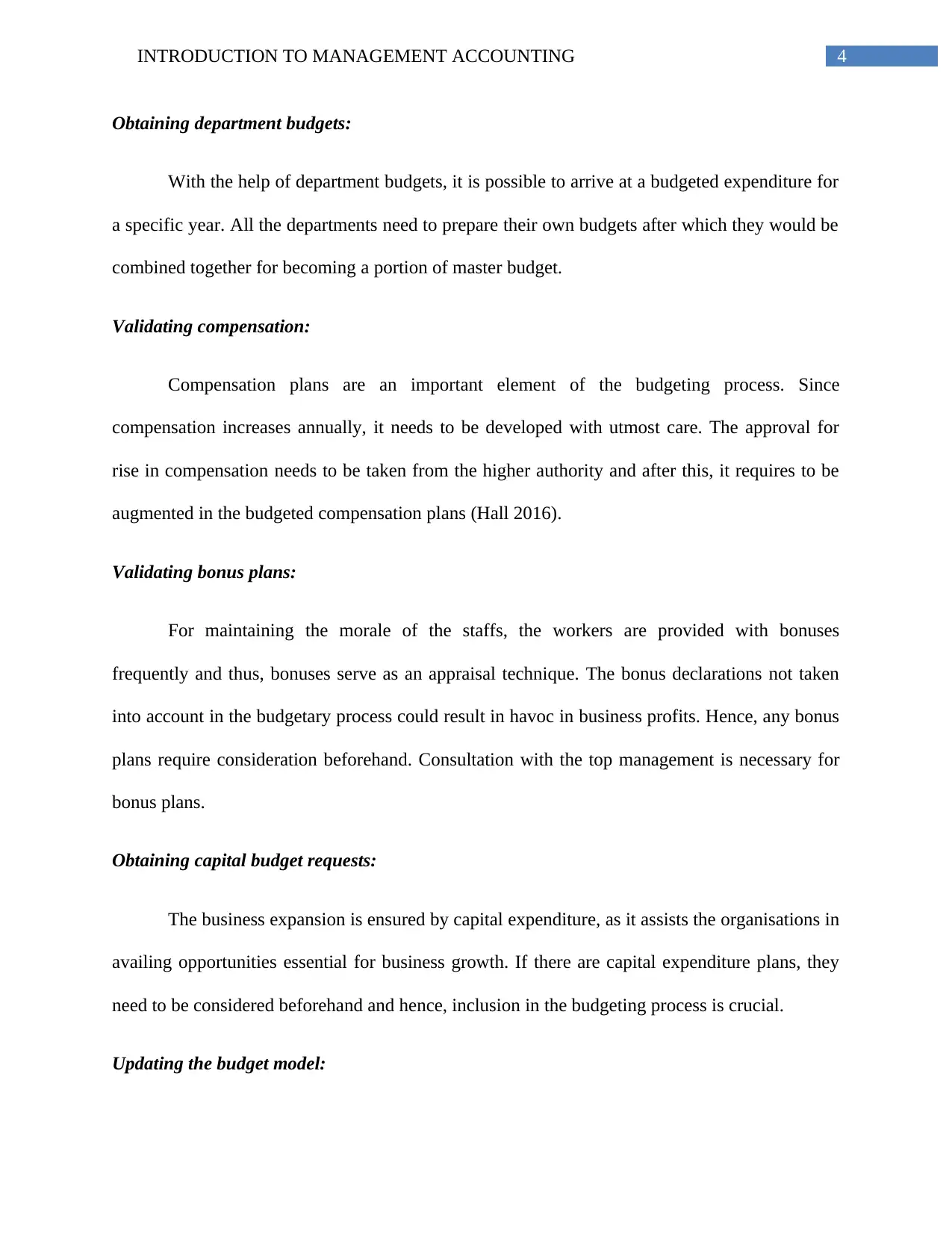
4INTRODUCTION TO MANAGEMENT ACCOUNTING
Obtaining department budgets:
With the help of department budgets, it is possible to arrive at a budgeted expenditure for
a specific year. All the departments need to prepare their own budgets after which they would be
combined together for becoming a portion of master budget.
Validating compensation:
Compensation plans are an important element of the budgeting process. Since
compensation increases annually, it needs to be developed with utmost care. The approval for
rise in compensation needs to be taken from the higher authority and after this, it requires to be
augmented in the budgeted compensation plans (Hall 2016).
Validating bonus plans:
For maintaining the morale of the staffs, the workers are provided with bonuses
frequently and thus, bonuses serve as an appraisal technique. The bonus declarations not taken
into account in the budgetary process could result in havoc in business profits. Hence, any bonus
plans require consideration beforehand. Consultation with the top management is necessary for
bonus plans.
Obtaining capital budget requests:
The business expansion is ensured by capital expenditure, as it assists the organisations in
availing opportunities essential for business growth. If there are capital expenditure plans, they
need to be considered beforehand and hence, inclusion in the budgeting process is crucial.
Updating the budget model:
Obtaining department budgets:
With the help of department budgets, it is possible to arrive at a budgeted expenditure for
a specific year. All the departments need to prepare their own budgets after which they would be
combined together for becoming a portion of master budget.
Validating compensation:
Compensation plans are an important element of the budgeting process. Since
compensation increases annually, it needs to be developed with utmost care. The approval for
rise in compensation needs to be taken from the higher authority and after this, it requires to be
augmented in the budgeted compensation plans (Hall 2016).
Validating bonus plans:
For maintaining the morale of the staffs, the workers are provided with bonuses
frequently and thus, bonuses serve as an appraisal technique. The bonus declarations not taken
into account in the budgetary process could result in havoc in business profits. Hence, any bonus
plans require consideration beforehand. Consultation with the top management is necessary for
bonus plans.
Obtaining capital budget requests:
The business expansion is ensured by capital expenditure, as it assists the organisations in
availing opportunities essential for business growth. If there are capital expenditure plans, they
need to be considered beforehand and hence, inclusion in the budgeting process is crucial.
Updating the budget model:
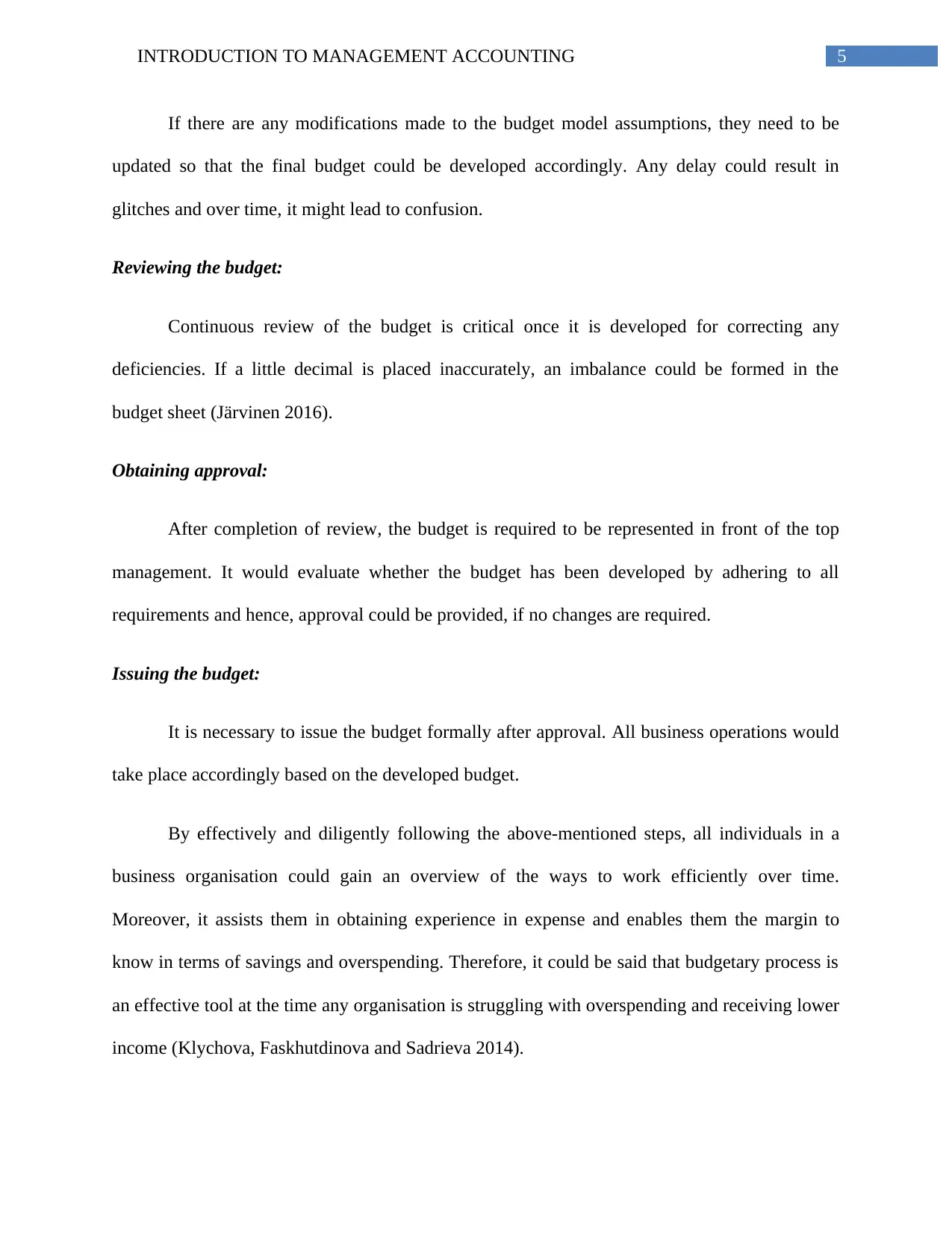
5INTRODUCTION TO MANAGEMENT ACCOUNTING
If there are any modifications made to the budget model assumptions, they need to be
updated so that the final budget could be developed accordingly. Any delay could result in
glitches and over time, it might lead to confusion.
Reviewing the budget:
Continuous review of the budget is critical once it is developed for correcting any
deficiencies. If a little decimal is placed inaccurately, an imbalance could be formed in the
budget sheet (Järvinen 2016).
Obtaining approval:
After completion of review, the budget is required to be represented in front of the top
management. It would evaluate whether the budget has been developed by adhering to all
requirements and hence, approval could be provided, if no changes are required.
Issuing the budget:
It is necessary to issue the budget formally after approval. All business operations would
take place accordingly based on the developed budget.
By effectively and diligently following the above-mentioned steps, all individuals in a
business organisation could gain an overview of the ways to work efficiently over time.
Moreover, it assists them in obtaining experience in expense and enables them the margin to
know in terms of savings and overspending. Therefore, it could be said that budgetary process is
an effective tool at the time any organisation is struggling with overspending and receiving lower
income (Klychova, Faskhutdinova and Sadrieva 2014).
If there are any modifications made to the budget model assumptions, they need to be
updated so that the final budget could be developed accordingly. Any delay could result in
glitches and over time, it might lead to confusion.
Reviewing the budget:
Continuous review of the budget is critical once it is developed for correcting any
deficiencies. If a little decimal is placed inaccurately, an imbalance could be formed in the
budget sheet (Järvinen 2016).
Obtaining approval:
After completion of review, the budget is required to be represented in front of the top
management. It would evaluate whether the budget has been developed by adhering to all
requirements and hence, approval could be provided, if no changes are required.
Issuing the budget:
It is necessary to issue the budget formally after approval. All business operations would
take place accordingly based on the developed budget.
By effectively and diligently following the above-mentioned steps, all individuals in a
business organisation could gain an overview of the ways to work efficiently over time.
Moreover, it assists them in obtaining experience in expense and enables them the margin to
know in terms of savings and overspending. Therefore, it could be said that budgetary process is
an effective tool at the time any organisation is struggling with overspending and receiving lower
income (Klychova, Faskhutdinova and Sadrieva 2014).
⊘ This is a preview!⊘
Do you want full access?
Subscribe today to unlock all pages.

Trusted by 1+ million students worldwide
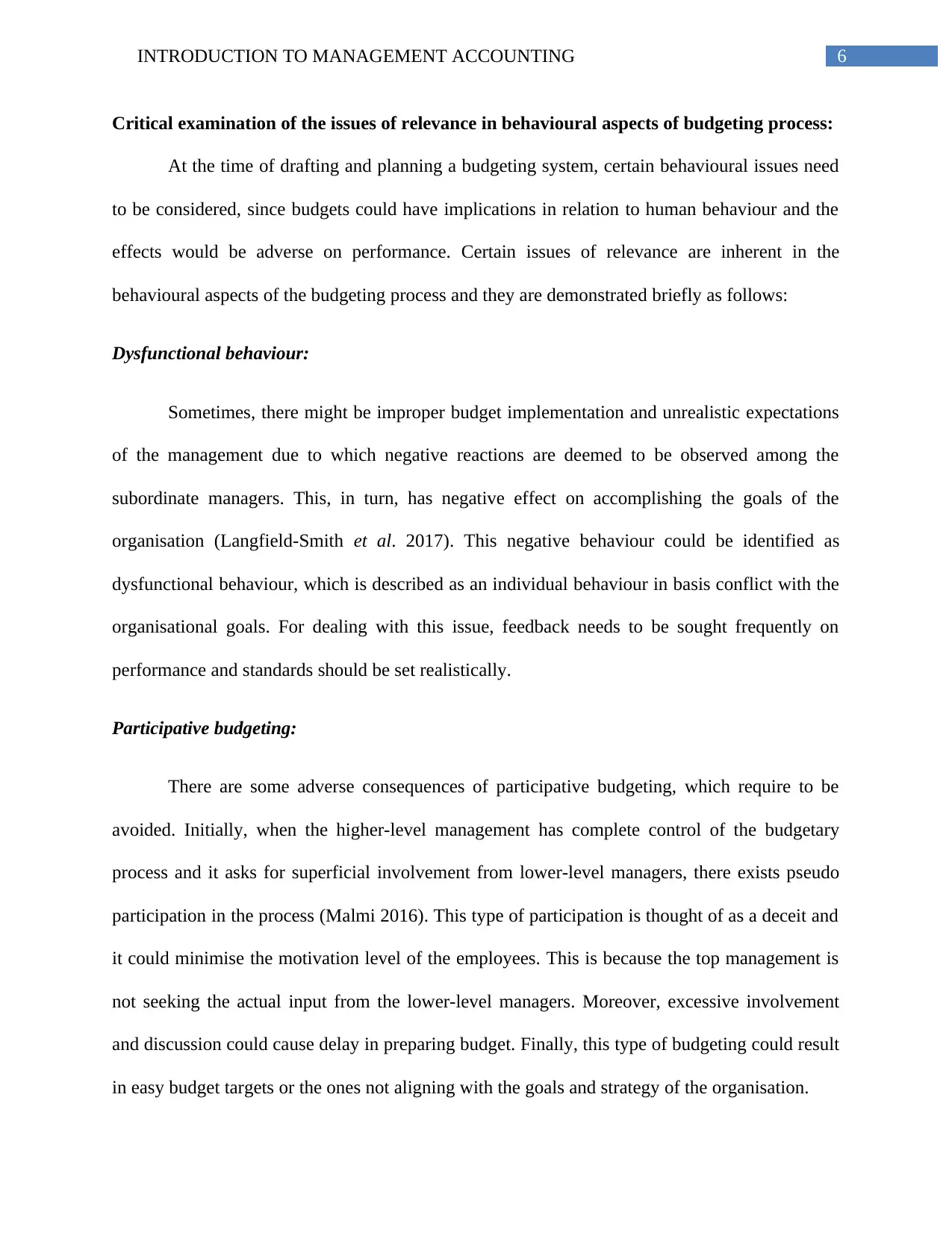
6INTRODUCTION TO MANAGEMENT ACCOUNTING
Critical examination of the issues of relevance in behavioural aspects of budgeting process:
At the time of drafting and planning a budgeting system, certain behavioural issues need
to be considered, since budgets could have implications in relation to human behaviour and the
effects would be adverse on performance. Certain issues of relevance are inherent in the
behavioural aspects of the budgeting process and they are demonstrated briefly as follows:
Dysfunctional behaviour:
Sometimes, there might be improper budget implementation and unrealistic expectations
of the management due to which negative reactions are deemed to be observed among the
subordinate managers. This, in turn, has negative effect on accomplishing the goals of the
organisation (Langfield-Smith et al. 2017). This negative behaviour could be identified as
dysfunctional behaviour, which is described as an individual behaviour in basis conflict with the
organisational goals. For dealing with this issue, feedback needs to be sought frequently on
performance and standards should be set realistically.
Participative budgeting:
There are some adverse consequences of participative budgeting, which require to be
avoided. Initially, when the higher-level management has complete control of the budgetary
process and it asks for superficial involvement from lower-level managers, there exists pseudo
participation in the process (Malmi 2016). This type of participation is thought of as a deceit and
it could minimise the motivation level of the employees. This is because the top management is
not seeking the actual input from the lower-level managers. Moreover, excessive involvement
and discussion could cause delay in preparing budget. Finally, this type of budgeting could result
in easy budget targets or the ones not aligning with the goals and strategy of the organisation.
Critical examination of the issues of relevance in behavioural aspects of budgeting process:
At the time of drafting and planning a budgeting system, certain behavioural issues need
to be considered, since budgets could have implications in relation to human behaviour and the
effects would be adverse on performance. Certain issues of relevance are inherent in the
behavioural aspects of the budgeting process and they are demonstrated briefly as follows:
Dysfunctional behaviour:
Sometimes, there might be improper budget implementation and unrealistic expectations
of the management due to which negative reactions are deemed to be observed among the
subordinate managers. This, in turn, has negative effect on accomplishing the goals of the
organisation (Langfield-Smith et al. 2017). This negative behaviour could be identified as
dysfunctional behaviour, which is described as an individual behaviour in basis conflict with the
organisational goals. For dealing with this issue, feedback needs to be sought frequently on
performance and standards should be set realistically.
Participative budgeting:
There are some adverse consequences of participative budgeting, which require to be
avoided. Initially, when the higher-level management has complete control of the budgetary
process and it asks for superficial involvement from lower-level managers, there exists pseudo
participation in the process (Malmi 2016). This type of participation is thought of as a deceit and
it could minimise the motivation level of the employees. This is because the top management is
not seeking the actual input from the lower-level managers. Moreover, excessive involvement
and discussion could cause delay in preparing budget. Finally, this type of budgeting could result
in easy budget targets or the ones not aligning with the goals and strategy of the organisation.
Paraphrase This Document
Need a fresh take? Get an instant paraphrase of this document with our AI Paraphraser

7INTRODUCTION TO MANAGEMENT ACCOUNTING
Additional pressure created by budget:
If the budget standards and goals are excessively high, there would be fall in motivation
and unable to accomplish the same might frustrate the managers, which would result in poor
performance. Conversely, if they are accomplished easily, the managers might lose interest and a
decline in performance is obvious. Therefore, it is necessary to tighten the standards and goals
within a certain range and the employees should be provided with the opportunity to give clear
feedbacks for adjusting levels of aspiration and striving to accomplish desired rewards (Miller
2018).
Budgetary slack (cushion):
This situation arises at the time any manager intentionally underestimates revenues, asks
for more funds than required and overestimates costs for supporting the budgeted activity level.
In all kinds of business organisations, a tendency could be observed in terms of introducing
cushion or slack into the budget. For example, the subordinate managers based on their previous
experiences could know that the senior managers would minimise their budget proposals and
hence, they would pad certain expenses or make low-revenue projections (Miller-Nobles,
Mattison and Matsumura 2016). Conversely, the senior managers having prior knowledge of the
habits of the subordinate managers might raise the expected revenue level and minimise
budgeted expenses. In a similar manner, the sales managers tend to underestimate sales
projections and the controller initiates slack by maintaining additional cash balances. For dealing
with this additional slack, the higher-level management might initiate strenuous measures to cut
costs along with putting additional pressure on minimising the slack.
Inter-departmental conflict:
Additional pressure created by budget:
If the budget standards and goals are excessively high, there would be fall in motivation
and unable to accomplish the same might frustrate the managers, which would result in poor
performance. Conversely, if they are accomplished easily, the managers might lose interest and a
decline in performance is obvious. Therefore, it is necessary to tighten the standards and goals
within a certain range and the employees should be provided with the opportunity to give clear
feedbacks for adjusting levels of aspiration and striving to accomplish desired rewards (Miller
2018).
Budgetary slack (cushion):
This situation arises at the time any manager intentionally underestimates revenues, asks
for more funds than required and overestimates costs for supporting the budgeted activity level.
In all kinds of business organisations, a tendency could be observed in terms of introducing
cushion or slack into the budget. For example, the subordinate managers based on their previous
experiences could know that the senior managers would minimise their budget proposals and
hence, they would pad certain expenses or make low-revenue projections (Miller-Nobles,
Mattison and Matsumura 2016). Conversely, the senior managers having prior knowledge of the
habits of the subordinate managers might raise the expected revenue level and minimise
budgeted expenses. In a similar manner, the sales managers tend to underestimate sales
projections and the controller initiates slack by maintaining additional cash balances. For dealing
with this additional slack, the higher-level management might initiate strenuous measures to cut
costs along with putting additional pressure on minimising the slack.
Inter-departmental conflict:

8INTRODUCTION TO MANAGEMENT ACCOUNTING
The budgetary process is effectively deemed to be a formal and technical one. However,
in practice, this process becomes an informal bargaining procedure or where the managers of
various departments compete for scarce resources of the organisation (Otley 2015). This might
result in dilution of actual goals, as the managers intend to fight for recognition and power.
Departmental conflict takes place mainly due to the fact that various departments tend to blame
each other when they are unable to accomplish their targets. In addition, conflicts are deemed to
be observed between the accounting department and the other departments of an organisation
due to varying perceptions. The reason is that the success of the budget staff is the failure of
another (Shields 2015). For instance, the success of an accounting in identifying an unfavourable
variance signifies the failure of another staff in accomplishing the budget. For dealing with this
issue, adequate training needs to be provided in human relations while enhancing communication
systems.
Support of the top management:
The top level managers need to develop an environment and provide impression to the
subordinate managers regarding their support and commitment to the budget objectives and goals
by their actions. In opposition, planning and control function would be damaged, if the
subordinate managers believe that their immediate supervisors are not diligent while developing
and using budgets (Van Helden and Uddin 2016). Hence, for dealing with this issue, the top
management needs to exhibit a positive attitude towards engaging lower management levels in
the process.
The budgetary process is effectively deemed to be a formal and technical one. However,
in practice, this process becomes an informal bargaining procedure or where the managers of
various departments compete for scarce resources of the organisation (Otley 2015). This might
result in dilution of actual goals, as the managers intend to fight for recognition and power.
Departmental conflict takes place mainly due to the fact that various departments tend to blame
each other when they are unable to accomplish their targets. In addition, conflicts are deemed to
be observed between the accounting department and the other departments of an organisation
due to varying perceptions. The reason is that the success of the budget staff is the failure of
another (Shields 2015). For instance, the success of an accounting in identifying an unfavourable
variance signifies the failure of another staff in accomplishing the budget. For dealing with this
issue, adequate training needs to be provided in human relations while enhancing communication
systems.
Support of the top management:
The top level managers need to develop an environment and provide impression to the
subordinate managers regarding their support and commitment to the budget objectives and goals
by their actions. In opposition, planning and control function would be damaged, if the
subordinate managers believe that their immediate supervisors are not diligent while developing
and using budgets (Van Helden and Uddin 2016). Hence, for dealing with this issue, the top
management needs to exhibit a positive attitude towards engaging lower management levels in
the process.
⊘ This is a preview!⊘
Do you want full access?
Subscribe today to unlock all pages.

Trusted by 1+ million students worldwide
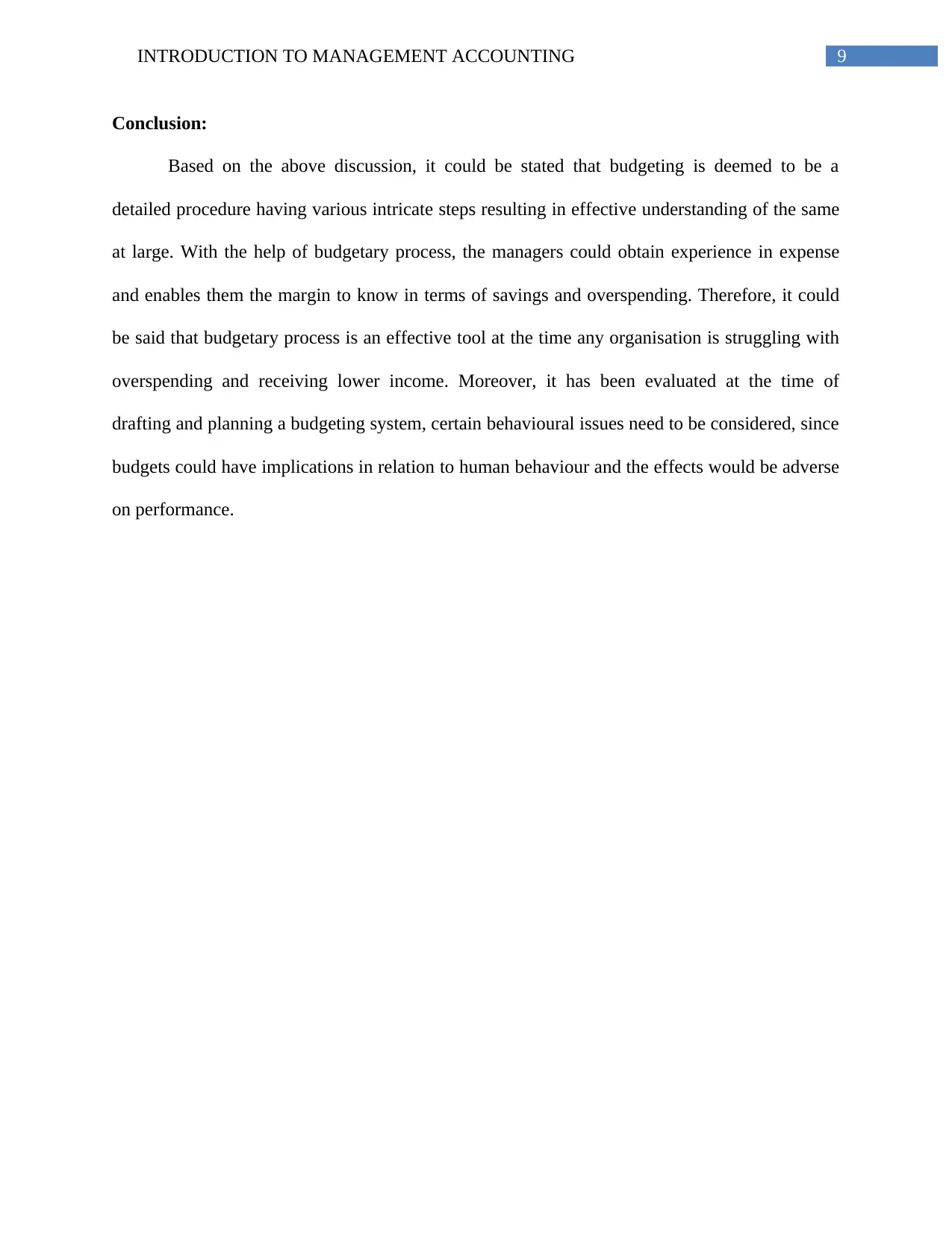
9INTRODUCTION TO MANAGEMENT ACCOUNTING
Conclusion:
Based on the above discussion, it could be stated that budgeting is deemed to be a
detailed procedure having various intricate steps resulting in effective understanding of the same
at large. With the help of budgetary process, the managers could obtain experience in expense
and enables them the margin to know in terms of savings and overspending. Therefore, it could
be said that budgetary process is an effective tool at the time any organisation is struggling with
overspending and receiving lower income. Moreover, it has been evaluated at the time of
drafting and planning a budgeting system, certain behavioural issues need to be considered, since
budgets could have implications in relation to human behaviour and the effects would be adverse
on performance.
Conclusion:
Based on the above discussion, it could be stated that budgeting is deemed to be a
detailed procedure having various intricate steps resulting in effective understanding of the same
at large. With the help of budgetary process, the managers could obtain experience in expense
and enables them the margin to know in terms of savings and overspending. Therefore, it could
be said that budgetary process is an effective tool at the time any organisation is struggling with
overspending and receiving lower income. Moreover, it has been evaluated at the time of
drafting and planning a budgeting system, certain behavioural issues need to be considered, since
budgets could have implications in relation to human behaviour and the effects would be adverse
on performance.
Paraphrase This Document
Need a fresh take? Get an instant paraphrase of this document with our AI Paraphraser
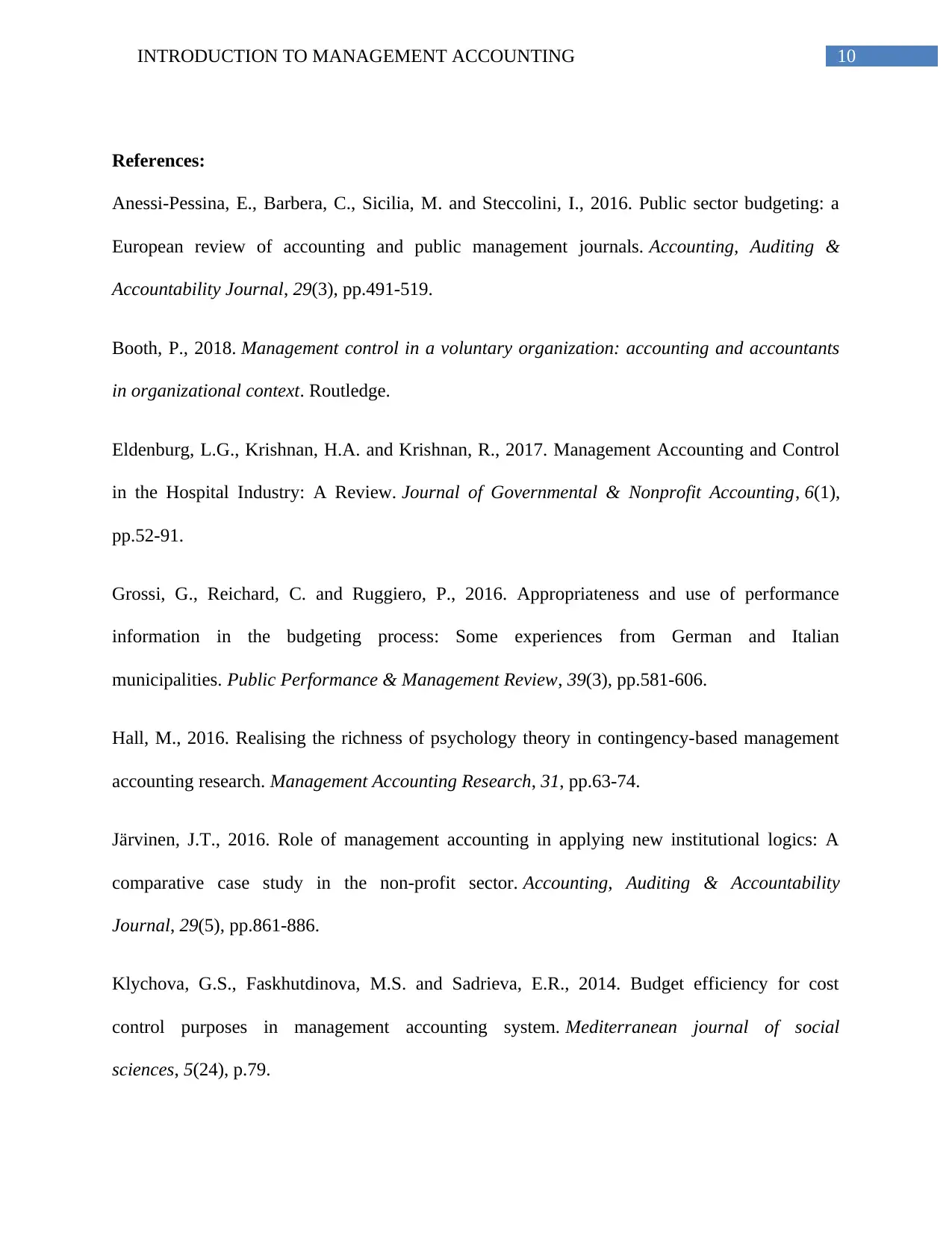
10INTRODUCTION TO MANAGEMENT ACCOUNTING
References:
Anessi-Pessina, E., Barbera, C., Sicilia, M. and Steccolini, I., 2016. Public sector budgeting: a
European review of accounting and public management journals. Accounting, Auditing &
Accountability Journal, 29(3), pp.491-519.
Booth, P., 2018. Management control in a voluntary organization: accounting and accountants
in organizational context. Routledge.
Eldenburg, L.G., Krishnan, H.A. and Krishnan, R., 2017. Management Accounting and Control
in the Hospital Industry: A Review. Journal of Governmental & Nonprofit Accounting, 6(1),
pp.52-91.
Grossi, G., Reichard, C. and Ruggiero, P., 2016. Appropriateness and use of performance
information in the budgeting process: Some experiences from German and Italian
municipalities. Public Performance & Management Review, 39(3), pp.581-606.
Hall, M., 2016. Realising the richness of psychology theory in contingency-based management
accounting research. Management Accounting Research, 31, pp.63-74.
Järvinen, J.T., 2016. Role of management accounting in applying new institutional logics: A
comparative case study in the non-profit sector. Accounting, Auditing & Accountability
Journal, 29(5), pp.861-886.
Klychova, G.S., Faskhutdinova, М.S. and Sadrieva, E.R., 2014. Budget efficiency for cost
control purposes in management accounting system. Mediterranean journal of social
sciences, 5(24), p.79.
References:
Anessi-Pessina, E., Barbera, C., Sicilia, M. and Steccolini, I., 2016. Public sector budgeting: a
European review of accounting and public management journals. Accounting, Auditing &
Accountability Journal, 29(3), pp.491-519.
Booth, P., 2018. Management control in a voluntary organization: accounting and accountants
in organizational context. Routledge.
Eldenburg, L.G., Krishnan, H.A. and Krishnan, R., 2017. Management Accounting and Control
in the Hospital Industry: A Review. Journal of Governmental & Nonprofit Accounting, 6(1),
pp.52-91.
Grossi, G., Reichard, C. and Ruggiero, P., 2016. Appropriateness and use of performance
information in the budgeting process: Some experiences from German and Italian
municipalities. Public Performance & Management Review, 39(3), pp.581-606.
Hall, M., 2016. Realising the richness of psychology theory in contingency-based management
accounting research. Management Accounting Research, 31, pp.63-74.
Järvinen, J.T., 2016. Role of management accounting in applying new institutional logics: A
comparative case study in the non-profit sector. Accounting, Auditing & Accountability
Journal, 29(5), pp.861-886.
Klychova, G.S., Faskhutdinova, М.S. and Sadrieva, E.R., 2014. Budget efficiency for cost
control purposes in management accounting system. Mediterranean journal of social
sciences, 5(24), p.79.

11INTRODUCTION TO MANAGEMENT ACCOUNTING
Langfield-Smith, K., Smith, D., Andon, P., Hilton, R. and Thorne, H., 2017. Management
accounting: Information for creating and managing value. McGraw-Hill Education Australia.
Malmi, T., 2016. Managerialist studies in management accounting: 1990–2014. Management
Accounting Research, 31, pp.31-44.
Miller, G., 2018. Performance based budgeting. Routledge.
Miller-Nobles, T.L., Mattison, B. and Matsumura, E.M., 2016. Horngren's Financial &
Managerial Accounting: The Managerial Chapters. Pearson.
Otley, D., 2015. In Management Control. Critical Perspectives in Management Control, 14(6)
pp.27-35.
Shields, M.D., 2015. Established management accounting knowledge. Journal of Management
Accounting Research, 27(1), pp.123-132.
Van Helden, J. and Uddin, S., 2016. Public sector management accounting in emerging
economies: A literature review. Critical Perspectives on Accounting, 41, pp.34-62.
Langfield-Smith, K., Smith, D., Andon, P., Hilton, R. and Thorne, H., 2017. Management
accounting: Information for creating and managing value. McGraw-Hill Education Australia.
Malmi, T., 2016. Managerialist studies in management accounting: 1990–2014. Management
Accounting Research, 31, pp.31-44.
Miller, G., 2018. Performance based budgeting. Routledge.
Miller-Nobles, T.L., Mattison, B. and Matsumura, E.M., 2016. Horngren's Financial &
Managerial Accounting: The Managerial Chapters. Pearson.
Otley, D., 2015. In Management Control. Critical Perspectives in Management Control, 14(6)
pp.27-35.
Shields, M.D., 2015. Established management accounting knowledge. Journal of Management
Accounting Research, 27(1), pp.123-132.
Van Helden, J. and Uddin, S., 2016. Public sector management accounting in emerging
economies: A literature review. Critical Perspectives on Accounting, 41, pp.34-62.
⊘ This is a preview!⊘
Do you want full access?
Subscribe today to unlock all pages.

Trusted by 1+ million students worldwide
1 out of 12
Related Documents
Your All-in-One AI-Powered Toolkit for Academic Success.
+13062052269
info@desklib.com
Available 24*7 on WhatsApp / Email
![[object Object]](/_next/static/media/star-bottom.7253800d.svg)
Unlock your academic potential
Copyright © 2020–2025 A2Z Services. All Rights Reserved. Developed and managed by ZUCOL.




